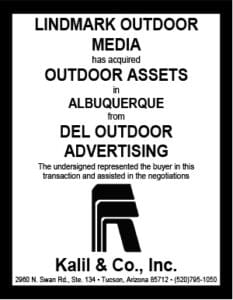
The new attorneys fees discount program for IBO members seems to be working as Chris Cowlbeck and I hoped, as I’ve received several inquiries from IBO members across the country about a variety of billboard litigation and transaction issues. For example, I was recently contacted by IBO members who had billboards being displaced by highway improvement projects in Pennsylvania and Oklahoma. In each case, the Department of Transportation had contacted the owners of the billboards, and offered them only reimbursement of their relocation expenses. While I certainly know the law, strategy, and advise in Texas, where I practice and am licensed, I had to research the question of whether billboards are compensable in eminent domain, and if so, how they are valued in Oklahoma and Pennsylvania. Despite identical facts confronting both the Oklahoma and Pennsylvania IBO members, the answers to the questions were vastly different under the law of the two states.
First, remember that the Fifth Amendment requires the payment of just compensation for the taking of private property for public use. Moreover, case law generally provides that “just compensation” means cash and not just relocation permits and expense reimbursement; and that “private property” means billboards and the leasehold or other interest upon which they are maintained, whether characterized as personalty or realty. These principles were certainly confirmed for the State of Texas in the 2015 Texas Supreme Court decision in State vs Clear Channel Outdoor, and they are followed by the courts in Oklahoma and Pennsylvania as well. Indeed, most courts across the county now agree that billboards are compensable in eminent domain, and that the government is obligated to pay “fair market value,” defined as “the amount of money which a willing purchaser will pay to a willing buyer, neither of which is under any obligation to buy or sell.” However, many states, such as Oklahoma and Pennsylvania, disagree on how that compensation is to be valued.
The practical differences on the legally approved methods of billboard compensation are meaningful. The three traditional means for valuing property in condemnation are the cost approach (cost of construction, less depreciation); comparable sales approach (comparative prices of similarly-situated properties in the market); and income approach (capitalization of the net rentals generated by the property). For a static double face steel monopole, with a face size of about 672 square feet and height of about 60 feet, the valuation under the cost approach might be $100,000 to $150,000. By contrast, a billboard generating advertising revenue of $60,000 per year might command over $1,000,000 under the comparable sales and income approaches.
Given the disparity of available compensation in the states, these IBO members from Oklahoma and Pennsylvania were obviously concerned about how the courts in their states would value their billboards condemned in eminent domain. And, while the courts in Oklahoma and Pennsylvania looked at the same basic facts (displacement of permitted billboards situated on valid leases to accommodate highway projects), and they even considered many of the same cases and highway beautification acts across the country, the courts in these two states came to very different conclusions. Specifically, the Oklahoma Supreme Court ruled in its 2014 decision in State of Oklahoma vs Lamar that the advertising revenue generated by the condemned billboard could be considered under the income and comparable sales approaches: “We agree that income generated from the rental of the sign’s faces can be a relevant factor for consideration in the determination of fair market value.” The leading case in Pennsylvania, however, held to the contrary. In Morgan Signs vs Pennsylvania Department of Transportation, the billboard owner offered evidence of multiples of the condemned signs’ advertising revenue in order to establish their fair market value for eminent domain purposes. PaDOT appealed the admission of this evidence, arguing the billboard owner was entitled only to the depreciated or relocation cost of the billboards, and the Commonwealth Court of Pennsylvania agreed in its 1999 decision: “The law in this Commonwealth is well settled that income flow evidence is inadmissible in determining the just compensation for property subject to condemnation.”
The laws of the other states where IBO members have billboards subject to highway projects and condemnation likely have differing approaches legally approved for the valuation of their displaced billboards as well.
[wpforms id=”9787″]
Paid Advertisement

















